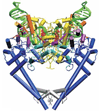Mechanisms of drug resistance: quinolone resistance
- PMID: 26190223
- PMCID: PMC4626314
- DOI: 10.1111/nyas.12830
Mechanisms of drug resistance: quinolone resistance
Abstract
Quinolone antimicrobials are synthetic and widely used in clinical medicine. Resistance emerged with clinical use and became common in some bacterial pathogens. Mechanisms of resistance include two categories of mutation and acquisition of resistance-conferring genes. Resistance mutations in one or both of the two drug target enzymes, DNA gyrase and DNA topoisomerase IV, are commonly in a localized domain of the GyrA and ParE subunits of the respective enzymes and reduce drug binding to the enzyme-DNA complex. Other resistance mutations occur in regulatory genes that control the expression of native efflux pumps localized in the bacterial membrane(s). These pumps have broad substrate profiles that include quinolones as well as other antimicrobials, disinfectants, and dyes. Mutations of both types can accumulate with selection pressure and produce highly resistant strains. Resistance genes acquired on plasmids can confer low-level resistance that promotes the selection of mutational high-level resistance. Plasmid-encoded resistance is due to Qnr proteins that protect the target enzymes from quinolone action, one mutant aminoglycoside-modifying enzyme that also modifies certain quinolones, and mobile efflux pumps. Plasmids with these mechanisms often encode additional antimicrobial resistances and can transfer multidrug resistance that includes quinolones. Thus, the bacterial quinolone resistance armamentarium is large.
Keywords: DNA gyrase; efflux pumps; plasmids; quinolone; topoisomerase.
© 2015 New York Academy of Sciences.
Figures



References
-
- Owens RC, Jr, Ambrose PG. Clinical use of the fluoroquinolones. Med. Clin. N. Amer. 2000;84:1447–1469. - PubMed
-
- Lesher GY, Forelich ED, Gruet MD, et al. 1,8-Naphthyridine derivatives. A new class of chemotherapeutic agents. J Medicinal Pharm Chem. 1962;5:1063–1068. - PubMed
-
- Domagala JM, Hagen SE. Structure-activity relationships of the quinolone antibacterials in the new millennium: some things change and some do not. In: Hooper DC, Rubinstein E, editors. Quinolone antimicrobial agents. 3rd. Washington, D.C: ASM Press; 2003. pp. 3–18.
-
- Hooper DC. Bacterial topoisomerases, anti-topoisomerases, and anti-topoisomerase resistance. Clin. Infect. Dis. 1997;27:S54–S63. - PubMed
Publication types
MeSH terms
Substances
Grants and funding
LinkOut - more resources
Full Text Sources
Other Literature Sources
Medical

